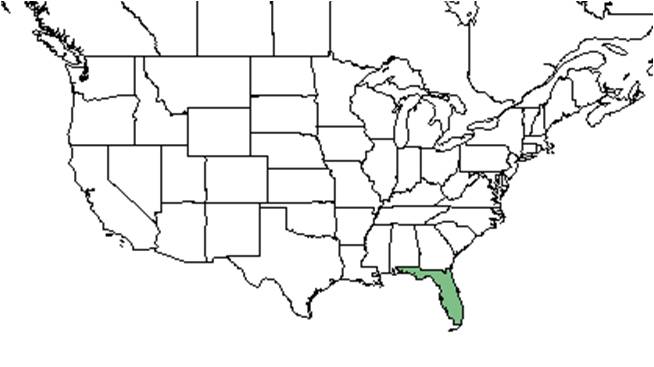Eryngium cuneifolium
| Eryngium cuneifolium | |
|---|---|
Error creating thumbnail: Unable to save thumbnail to destination
| |
| Scientific classification | |
| Kingdom: | Plantae |
| Division: | Magnoliophyta - Flowering plants |
| Class: | Magnoliopsida - Dicotyledons |
| Order: | Apiales |
| Family: | Apiaceae ⁄ Umbelliferae |
| Genus: | Eryngium |
| Species: | E. cuneifolium |
| Binomial name | |
| Eryngium cuneifolium Small | |

| |
| Natural range of Eryngium cuneifolium from USDA NRCS Plants Database. | |
Common name: wedgeleaf eryngo
Contents
Taxonomic notes
Description
It is a aromatic perennial herb with a basal rosette [1] that starts flowering 2 to 3 years after germination (Menges and Quintana-Ascencio 2004). It is endemic to the pyrogenic Ceratiola scrubs of the southern portion of the Lake Wales ridge and has developed a long, woody taproot to cope with the limited nutrient and water availability (Menges and Quintana-Ascencio 2004). Basal leaves are long, stalked and shaped like narrow wedges with 3 to 5 bristle-tipped teeth at the apex [1]. Perfect flower are arranged in a compound umbel and are small with white petals, filaments, styles and stigmas[2][1].
Distribution
Eryngium cuneifolium is limited to a narrow geographic range in the southern portion of the Lake Wales Ridge in Ceratiola scrubs [1].
Ecology
Habitat
E. cuneifolium is limited to the southern portion of the Lake Wales Ridge in acidic, excessively well drained, white sands of the St. Lucie or Archold series (hyperthermic, uncoated typic quartzipsamments)(Hawkes 2004). It can be found in exposed openings in Ceratiola ericoides scrubs created by fire and other disturbances (FSU Herbarium; Menges and Kimmich 1996). Individuals are sensitive to microhabitat conditions, such as disturbance, plant cover and fire regime. Allelopathic chemicals released from Ceratiola ericioides and Calamintha ashei can inhibit germination and survival of E. cuneifolium (Hawkes 2004; Menges and Kimmich 1996). Associated species include Pinus elliottii, P. clausa, Quercus myrtifolia, Bumelia tenax, Persea palustris, Lyonia, Palafocia feayi, Sabal etonia, Liatris ohlingeae, Hypericum cumulicola, Lechea cernua, Quercus inopina, Q. geminanta, Q. chapmannii, Ximenia americana, Palafoxia feayi, Opuntia humifusa, Smilax auriculata, Nolina brittonia,and Polygonella fimbriata [2](FSU Herbarium).
Phenology
Flowers and fruits April through November (FSU Herbarium). The perfect flowers are clustered in groups of 9-15 on a headlike compressed umbel and arranged in a compound umbel (Menges and Kimmich 1996). The flowers are protandrous and mature rapidly, with each umbel passing through a male phase, then a brief sexually inactive phase, followed by a female phase (Evans et al. 2003). The flowers produce nectar, pollen and odor to attract pollinators and have a low rate of inbreeding.
Seed dispersal
Fruits are small schizocarps and dispersed barochorically (Hawkes 2004; Menges and Kimmich 1996).
Seed bank and germination
The seeds of E. cuneifolium are small, making germination susceptible to microsite changes and soil crust characteristics (Hawkes 2004). Germination occurs a year after sowing (Quintana-Ascencio and Menges 2000) and germination is inhibited by water soluble litter and leachates from C. ericoides (Hawkes 2004). The persistent seed banks of E. cuneifolium may use allelochemicals from Ceratiola as a cue to induce seed dormancy in order to avoid competition with Ceratiola (Hunter and Menges 2002).
Fire ecology
Florida rosemary scrubs recover slowly post-fire compared to other scrubs and the scrub structure progressively changes for decades in between fires (Johnson and Abrahamson 1990). E. cuneifolium depends on gaps in the Florida rosemary scrub, due to limiting microhabitat conditions and it's failure to thrive in close proximity to Ceratiola ericoides and Calamintha ashei due to allelopathic chemicals leached by both species (Menges and Kimmich 1996). Fires kill all C. ericoides individuals , and early postfire conditions of low shrub cover and limited competition are ideal for E. cuneifolium germination. Menges and Quintana-Ascencio (2004) found that individuals in recently burned areas live long, survive better, grow faster and flower earlier than those that germinate in areas that have not burned recently. Fire has a positive effect on seed production, recruitment and survival, with seedlings appearing within a year of fire.
Pollination
The following Hymenoptera families and species were observed visiting flowers of Eryngium cuneifolium at Archbold Biological Station (Deyrup 2015):
Apidae: Bombus pennsylvanicus
Colletidae: Colletes mandibularis
Halictidae: Augochlora pura, Augochlorella aurata, Augochloropsis sumptuosa, Lasioglossum miniatulus, L. nymphalis, L. placidensis, Sphecodes heraclei
Leucospididae: Leucospis affinis, L. robertsoni, L. slossonae
Megachilidae: Anthidiellum perplexum, Coelioxys mexicana, C. octodentata, C. sayi, Dianthidium floridiense, Megachile albitarsis, M. brevis pseudobrevis, M. mendica, M. texana
Pompilidae: Episyron conterminus posterus
Sphecidae: Anacrabro ocellatus, Bembix sayi, Bicyrtes capnoptera, Cerceris blakei, C. flavofasciata floridensis, Ectemnius rufipes ais, Isodontia exornata, Oxybelus laetus fulvipes, Philanthus politus, Prionyx thomae, Sphex ichneumoneus, Tachysphex similis, Tachytes guatemalensis, T. validus
Vespidae: Euodynerus boscii boharti, E. castigatus rubrivestris, Pachodynerus erynnis, Polistes perplexus
Use by animals
Diseases and parasites
Conservation and Management
Cultivation and restoration
Photo Gallery
References and notes
Deyrup, M.A. and N.D. 2015. Database of observations of Hymenoptera visitations to flowers of plants on Archbold Biological Station, Florida, USA.
Florida State University Robert K. Godfrey Herbarium database. URL: http://herbarium.bio.fsu.edu. Last accessed: October 2015. Collectors: Beverly Judd, Walter S. Judd, R. Kral, Siri von Reis. States and Counties: Florida: Highlands, St. Lucie. Compiled by Tall Timbers Research Station and Land Conservancy.